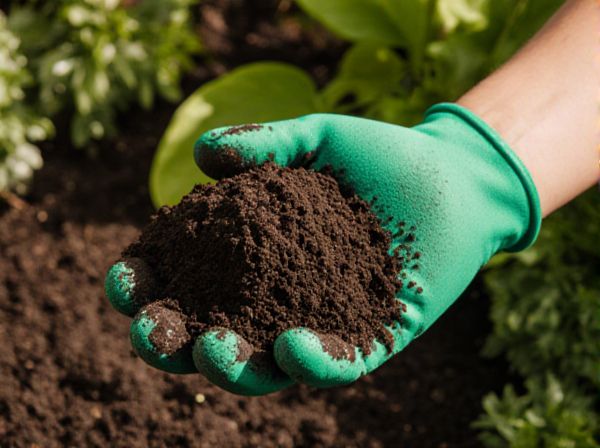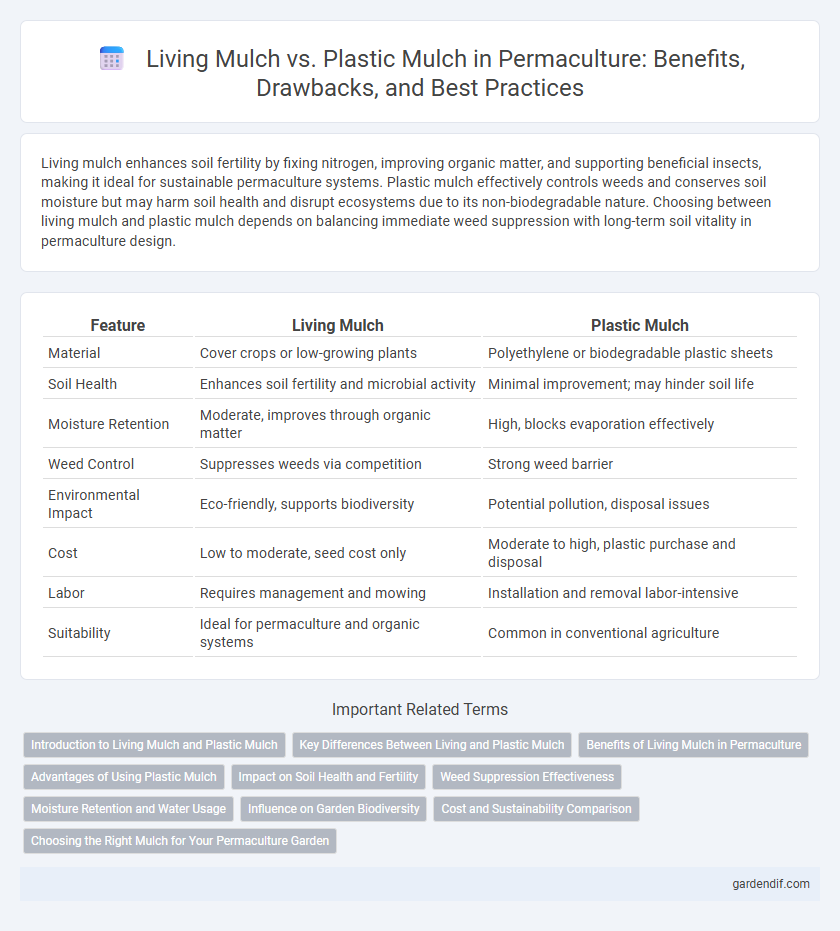
Living Mulch vs Plastic Mulch Illustration
Living mulch enhances soil fertility by fixing nitrogen, improving organic matter, and supporting beneficial insects, making it ideal for sustainable permaculture systems. Plastic mulch effectively controls weeds and conserves soil moisture but may harm soil health and disrupt ecosystems due to its non-biodegradable nature. Choosing between living mulch and plastic mulch depends on balancing immediate weed suppression with long-term soil vitality in permaculture design.
Table of Comparison
| Feature | Living Mulch | Plastic Mulch |
|---|---|---|
| Material | Cover crops or low-growing plants | Polyethylene or biodegradable plastic sheets |
| Soil Health | Enhances soil fertility and microbial activity | Minimal improvement; may hinder soil life |
| Moisture Retention | Moderate, improves through organic matter | High, blocks evaporation effectively |
| Weed Control | Suppresses weeds via competition | Strong weed barrier |
| Environmental Impact | Eco-friendly, supports biodiversity | Potential pollution, disposal issues |
| Cost | Low to moderate, seed cost only | Moderate to high, plastic purchase and disposal |
| Labor | Requires management and mowing | Installation and removal labor-intensive |
| Suitability | Ideal for permaculture and organic systems | Common in conventional agriculture |
Introduction to Living Mulch and Plastic Mulch
Living mulch involves growing cover crops such as clover or vetch between rows of main crops, enhancing soil fertility, moisture retention, and biodiversity through natural processes. Plastic mulch uses polyethylene sheets to suppress weeds, conserve soil moisture, and increase soil temperature, often leading to higher crop yields but with environmental concerns related to plastic disposal. Choosing between living mulch and plastic mulch depends on balancing ecological benefits with crop productivity and sustainability goals in permaculture systems.
Key Differences Between Living and Plastic Mulch
Living mulch consists of cover crops planted alongside main crops, enhancing soil fertility, moisture retention, and biodiversity, while plastic mulch is a synthetic barrier that suppresses weeds and conserves soil moisture but lacks ecological benefits. Unlike plastic mulch, living mulch promotes natural pest control, reduces soil erosion, and improves organic matter content, making it a sustainable option in permaculture practices. However, plastic mulch is more effective in temperature regulation and weed suppression but generates waste and can disrupt soil microbial activity.
Benefits of Living Mulch in Permaculture
Living mulch in permaculture improves soil fertility by fixing nitrogen and enhancing microbial activity, which boosts plant health and yield naturally. It supports biodiversity by providing habitat for beneficial insects and reducing pest pressure without harmful chemicals. Living mulch also improves soil structure and moisture retention, promoting sustainable water use and reducing erosion compared to plastic mulch.
Advantages of Using Plastic Mulch
Plastic mulch enhances soil temperature regulation, promoting faster plant growth and higher crop yields compared to living mulch. It effectively suppresses weeds by blocking sunlight, reducing the need for herbicides and manual weeding. The mulching also conserves soil moisture, improving water-use efficiency and supporting healthier root development.
Impact on Soil Health and Fertility
Living mulch enhances soil health by promoting biodiversity, increasing organic matter, and improving nutrient cycling through nitrogen fixation and microbial activity. Plastic mulch, while effective at moisture retention and weed control, can hinder soil aeration and microbial life, leading to reduced soil fertility over time. Sustainable permaculture practices favor living mulch to maintain long-term soil structure and ecosystem vitality.
Weed Suppression Effectiveness
Living mulch, such as cover crops or low-growing plants, effectively suppresses weeds by shading soil and competing for nutrients, enhancing soil health and biodiversity. Plastic mulch offers immediate and robust weed control by blocking sunlight and creating a physical barrier, but it lacks the ecological benefits and can lead to soil temperature extremes. Combining living mulch with selective use of plastic mulch can optimize weed suppression while promoting sustainable soil management in permaculture systems.
Moisture Retention and Water Usage
Living mulch enhances soil moisture retention by creating a natural ground cover that reduces evaporation and improves water infiltration through its root structure. In contrast, plastic mulch effectively limits moisture loss by acting as a barrier but can cause soil overheating and reduced water permeability. Studies show living mulch systems reduce irrigation needs by up to 30%, promoting sustainable water usage compared to plastic mulch.
Influence on Garden Biodiversity
Living mulch significantly enhances garden biodiversity by providing habitat and food sources for beneficial insects, microbes, and soil organisms, promoting a healthy and resilient ecosystem. In contrast, plastic mulch often reduces biodiversity by creating a barrier that inhibits soil organism activity and limits plant variety due to its non-porous nature and lack of organic matter. Integrating living mulch supports natural pest control and nutrient cycling, essential for sustainable permaculture practices.
Cost and Sustainability Comparison
Living mulch significantly reduces long-term expenses by improving soil fertility and moisture retention, minimizing the need for synthetic fertilizers and irrigation. Plastic mulch entails higher upfront costs and contributes to environmental waste due to its non-biodegradable nature, creating sustainability challenges. The use of living mulch supports regenerative agriculture by enhancing biodiversity and carbon sequestration, making it a more eco-friendly and cost-effective option compared to plastic alternatives.
Choosing the Right Mulch for Your Permaculture Garden
Living mulch enhances soil fertility and biodiversity by providing continuous organic matter and habitat for beneficial organisms, promoting long-term soil health in permaculture gardens. Plastic mulch offers effective weed suppression and moisture retention but can disrupt soil ecosystems and require careful disposal to avoid environmental harm. Selecting the right mulch depends on balancing ecological benefits with practical needs like weed control, water conservation, and garden sustainability goals.
Living Mulch vs Plastic Mulch Infographic

 gardendif.com
gardendif.com